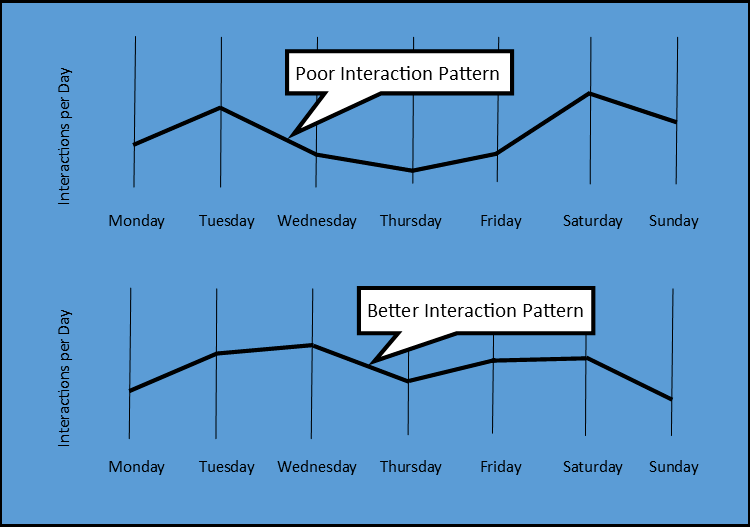2 Techniques To Encourage Continuously Interactive Online Discussions
Teaching for-credit online courses at state, private, and for-profit universities involves many challenges, not the least of which is ensuring that weekly discussions are lively, informative, and constructive for students. Similar challenges are faced in the non-credit world of corporate training. As instructors, we want ways to promote the best kinds of learning and knowledge exchange in discussions. In this article I’ll discuss two basic strategies I have used. Most of my experience is in for-credit education, so I am going to assume that the instructor is in the position of being able to motivate students through grading as well as through other means.
The de facto standard in online higher education is the weekly discussion question. Weekly discussion questions should be formative experiences that enrich and deepen the student’s knowledge. I stress should be because the levels of interaction – the number and kinds of posts throughout the week – often fail to meet the optimum. Ideally, the classmates should be chomping at the bit to answer the week’s discussion question as soon as it appears on the first day of the class week – I have been in a few graduate classes like that! By Wednesday (let’s assume a Monday through Sunday class week), most of the class members have logged their initial responses to the DQ (Discussion Question) and are already engaged in friendly repartee that will last through the end of the week.
In reality, discussions often take the opposite form: many students view the discussion questions as an item to be dispensed with rather than an opportunity for knowledge enhancement by understanding and critically responding to the perspectives of others. Instead of posting early in the week, students put it off until the weekend and then quickly type their initial response to the DQ and a few half-hearted responses to their peers. Needless to say, with only a few days remaining in the week there is hardly time for the class as a whole to experience a meaningful set of points and counterpoints. In fact, some of the discussion grading rubrics typical of for-profit universities fail to discourage this kind of behavior. If the rubric specifies that only such things as the number, length, quality, and accuracy of the posts are graded and not such things as “timely contribution to discussion,” the instructor cannot dock students any points for making all of his or her posts for the week between 10:00 pm and 11:55 pm on Sunday. Yes, these kinds of grading policies are intended to make allowances for the busy schedules of working adults. (In the online for-credit sector, the current typical student is a woman in her mid-30s with children and a full-time job!) But from a strictly educational point of view, these kinds of grading policies do not result in the vibrant discussions envisioned by bright-eyed instructors. What is an instructor to do?
Technique 1: Instilling a Sense of Social Purpose
This leads to my first technique: instilling a sense of social purpose into the class. Remind students that online learning is a collaborative group venture that is only as good as the participants want to make it. Steer the class away from turning the class into a contest of individuals. Encourage students to make the exchange of information and viewpoints the center of their learning experience. Make sure students understand that it is their class, not yours or the institution’s. I often tell classes that I am looking not just for energy (individual efforts) but synergy – active help to each other throughout the week.
For example, near the start of the class you might use announcements like these:
- In reviewing your bios, I have calculated that total experience in this class of 18 amounts to almost 220 years of expertise! That’s a lot of knowledge. Be sure to share your experience and insights with others in our weekly DQs.
- I am seeing lots of good initial responses to our discussion question this week, but not enough in the way of helpful criticism. Please make sure you are doing your part to raise the level of critical commentary in the class.
When you see a pickup in constructive interactivity, be sure to praise the class:
- This week featured good interactions. Ideas were exchanged and great points were made. Keep the synergy going!
Another way to encourage better interactions is to occasionally pick out a single individual or a small group of posters and encourage them:
- Great post, Frank! But did you see how Yvette and Chris responded to the same question? I suggest you take a look and share your insights with them.
I have had good success with the social purpose approach to developing communal efforts. A kind of peer pressure often results, where students start to encourage each other, making your own cheerleading less necessary.
Technique 2: Bonus Points
Let’s be frank. In most classes there are stragglers, people who don’t want to be there, and people who should not be there. In most cases, this group posts at the end of the week or, nearly as bad, they sign in once a week, make a few posts, and are never heard from again. At the other end of the academic spectrum, there are enthusiastic students who post at the beginning of the week, exchange ideas with other good students, but often also stop posting for the rest of the week. You want better students to share knowledge and provide constructive criticism to students who are struggling and you want a more even flow of posts during the week.
To help encourage a more even flow of posts, I inserted a timeliness grading system into a standard discussion grading rubric that also measured other aspects of posts, such as quality, courtesy, and freedom from errors.
| Timeliness | All posts are after Friday or all posts on a single day | First post no later than Wednesday; other posts prior to end of week | Posts early: First post no later than Wednesday; at least one other post Friday or before; posts on several days of the week |
| 0 pts | 1 pts | 2 pts |
The total number of points possible in my rubric was 13, so the effect of awarding 2 points for timeliness was to add about 15% to the grade. Keep in mind this rubric used a Monday through Sunday time frame.
It won’t do to just post your rubric with a timeliness component like the one above in it. Make sure to explain what the rubric means in terms of grades by spelling out a couple of examples:
- If you post early (before Wednesday) and respond to at least one other student before Friday, you will get full credit for timeliness.
- If you post on Monday and Saturday only, you get 1 point for timeliness.
- If you post just one day per week, you lose 2 points for timeliness. No matter how good your posts are, you can score no higher than a “B.”
You might find that some students with busy schedules will balk at this scheme, but in my own experience I encountered no problems. In fact, it worked exactly as I wanted. Poorer students in the habit of posting on weekends only soon realized they could get a letter grade boost by posting early. Even if their posts were mediocre in other respects, they could get still get a “B.”
In summary, encouraging continuously interactive discussions is an essential task of the instructor, but by using the right techniques it is a job that can be accomplished fairly easily. By inspiring your students to work toward the greater good by helping each other, by promoting synergy, and by using appropriate point incentives, your discussions should be more fruitful for both you and your students.








